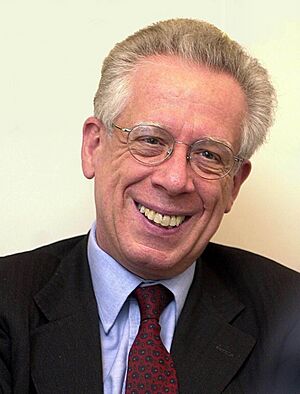Tommaso Padoa-Schioppa facts for kids
Quick facts for kids
Tommaso Padoa-Schioppa, OMRI
|
|
|---|---|

Padoa-Schioppa in 2008
|
|
| Minister of Economy and Finance | |
| In office 17 May 2006 – 8 May 2008 |
|
| Prime Minister | Romano Prodi |
| Preceded by | Giulio Tremonti |
| Succeeded by | Giulio Tremonti |
| Member of the Executive Board of the European Central Bank | |
| In office 1 June 1998 – 31 May 2005 |
|
| Preceded by | Position established |
| Succeeded by | Lorenzo Bini Smaghi |
| Personal details | |
| Born | 23 July 1940 Belluno, Veneto, Kingdom of Italy |
| Died | 18 December 2010 (aged 70) Rome, Lazio, Italy |
| Political party | Independent |
| Spouse |
Fiorella Kostoris
(divorced) |
| Domestic partner | Barbara Spinelli |
| Children | 3 |
| Education | Bocconi University Massachusetts Institute of Technology |
Tommaso Padoa-Schioppa (born July 23, 1940 – died December 18, 2010) was an important Italian banker and economist. He served as Italy's Minister of Economy and Finance from 2006 to 2008. Before that, he was a member of the Executive Board of the European Central Bank from 1998 to 2005. Many people see Padoa-Schioppa as one of the main people who helped create the Euro.
Contents
About His Life
Tommaso Padoa-Schioppa was born in Belluno, a mountain town in north-eastern Italy. His parents were both very smart people. He didn't meet his father until 1945, after World War II ended. His father later became a top leader at a big insurance company.
Education and Early Career
He went to Bocconi University in Milan and graduated in 1966. Then, in 1970, he earned a master's degree from the Massachusetts Institute of Technology (MIT) in the United States.
After working briefly in Germany, he joined the Bank of Italy in 1968. He worked his way up and became the Vice-Director General from 1984 to 1997. He was also part of important financial groups like the Group of Thirty. From 1993 to 1997, he led the Basel Committee on Banking Supervision, which helps make banking rules.
Role at the European Central Bank
Padoa-Schioppa was one of the first members of the European Central Bank's executive board. He served there from when it started in 1998 until May 2005. This bank is very important because it manages the Euro currency for many European countries.
Minister of Economy and Finance
On May 17, 2006, he became Italy's Minister of Economy and Finance. He held this job until May 2008. In this role, he was in charge of Italy's money and financial system. He also chaired a key committee for the International Monetary Fund (IMF) from 2007 to 2008.
Family Life
Tommaso Padoa-Schioppa was married to an economist named Fiorella Kostoris. They had three children together. After they divorced, he was with Barbara Spinelli, who is a journalist.
His Passing
Tommaso Padoa-Schioppa passed away on December 18, 2010, at the age of 70. He had a heart attack during a dinner he had organized in Rome.
Words He Made Popular
Tommaso Padoa-Schioppa sometimes used phrases that became very well-known in Italy.
"Il Tesoretto" (The Little Treasure)
In 2006, he used the phrase "il tesoretto" to describe extra money the government had collected. This "little treasure" became a big topic of discussion among politicians about how to spend it.
"Bamboccioni" (Big Dummy Boys)
In 2007, he used the word "bamboccioni" when talking about a plan to help young adults (20-30 years old) move out of their parents' homes. He meant it in a sarcastic way, suggesting these young people were still like "big stuffed children" living at home.
This word caused a lot of debate in Italy. Many young people and their families felt offended. They wrote letters to newspapers, explaining that it was hard for them to afford their own place because they didn't earn much money. "Bamboccioni" became one of the most popular new Italian words of 2007.
How He Helped Create the Euro
Padoa-Schioppa is often called the "founding father" of the Euro. He was a very important thinker behind the idea of a single European currency.
The "Inconsistent Quartet"
In 1982, he wrote about a problem he called the "inconsistent quartet." He explained that a group of countries like those in Europe could not have all four of these things at the same time:
- Free trade (no taxes or limits on goods moving between countries).
- Capital mobility (money moving freely between countries).
- Countries setting their own money rules (independent monetary policies).
- Fixed exchange rates (the value of one country's money always stays the same compared to another's).
He said that if countries wanted free trade, easy money movement, and fixed exchange rates, they would have to give up one thing: each country setting its own money rules.
The Solution: A Single Currency
Padoa-Schioppa suggested that European countries should create a single currency and a single central bank. This would mean they would share one set of money rules, allowing them to have free trade, easy money movement, and stable exchange rates.
His ideas were very important for the Delors Report in 1989, which recommended creating a European Monetary Union (EMU) with a single currency. He then helped design and set up the new European Central Bank and was one of its first leaders.
Images for kids
-
Padoa-Schioppa and Wim Duisenberg during an International Monetary Fund meeting in Washington, D.C. on September 24, 2000.
See also
- Delors Committee


